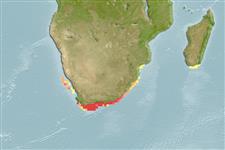>
Centrarchiformes (Basses) >
Latridae (Trumpeters)
Etymology: Chirodactylus: Greek, cheir = hand + Greek, daktylos = finger (Ref. 45335); for the long, unbranched lower pectoral fin rays (Ref. 120445).
More on author: Günther.
Environment: milieu / climate zone / rango de profundidad / distribution range
Ecología
marino demersal; rango de profundidad 0 - 150 m (Ref. 9492). Subtropical; 23°S - 36°S
Southeast Atlantic: Walvis Bay, Namibia to possibly Natal, South Africa. Natal records are likely to be Chirodactylus jessicalorum.
Tamaño / Peso / Age
Madurez: Lm ? range ? - ? cm
Max length : 180 cm TL macho / no sexado; (Ref. 9492); common length : 80.0 cm TL macho / no sexado; (Ref. 9492)
Short description
Claves de identificación | Morfología | Morfometría
Espinas dorsales (total) : 17 - 18; Radios blandos dorsales (total) : 22 - 24; Espinas anales: 3; Radios blandos anales: 8.
Body shape (shape guide): short and / or deep.
The largest species of the family (Ref. 5319). Primarily an offshore species that prefers rocky or muddy banks. Feeds during the day on small, bottom-dwelling invertebrates. Occasionally also on squid and small fish. Also caught by artisanal and game fisheries (Ref. 9492).
Life cycle and mating behavior
Madurez | Reproducción | Puesta | Huevos | Fecundidad | Larva
Smith, M.M., 1986. Cheilodactylidae. p. 667-668. In M.M. Smith and P.C. Heemstra (eds.) Smiths' sea fishes. Springer-Verlag, Berlin. (Ref. 5319)
IUCN Red List Status (Ref. 130435: Version 2024-2)
Threat to humans
Harmless
Human uses
Pesquerías: escaso valor comercial; pesca deportiva: si
Herramientas
Special reports
Download XML
Fuentes de Internet
Estimates based on models
Preferred temperature (Referencia
123201): 15.4 - 23.9, mean 18.1 °C (based on 40 cells).
Phylogenetic diversity index (Referencia
82804): PD
50 = 0.5312 [Uniqueness, from 0.5 = low to 2.0 = high].
Bayesian length-weight: a=0.01820 (0.00741 - 0.04467), b=2.99 (2.77 - 3.21), in cm total length, based on LWR estimates for this (Sub)family-body shape (Ref.
93245).
Nivel trófico (Referencia
69278): 3.3 ±0.3 se; based on diet studies.
Resiliencia (Referencia
120179): Muy bajo, población duplicada en un tiempo mínimo superior a 14 años (Preliminary K or Fecundity.).
Fishing Vulnerability (Ref.
59153): Very high vulnerability (90 of 100).
🛈
